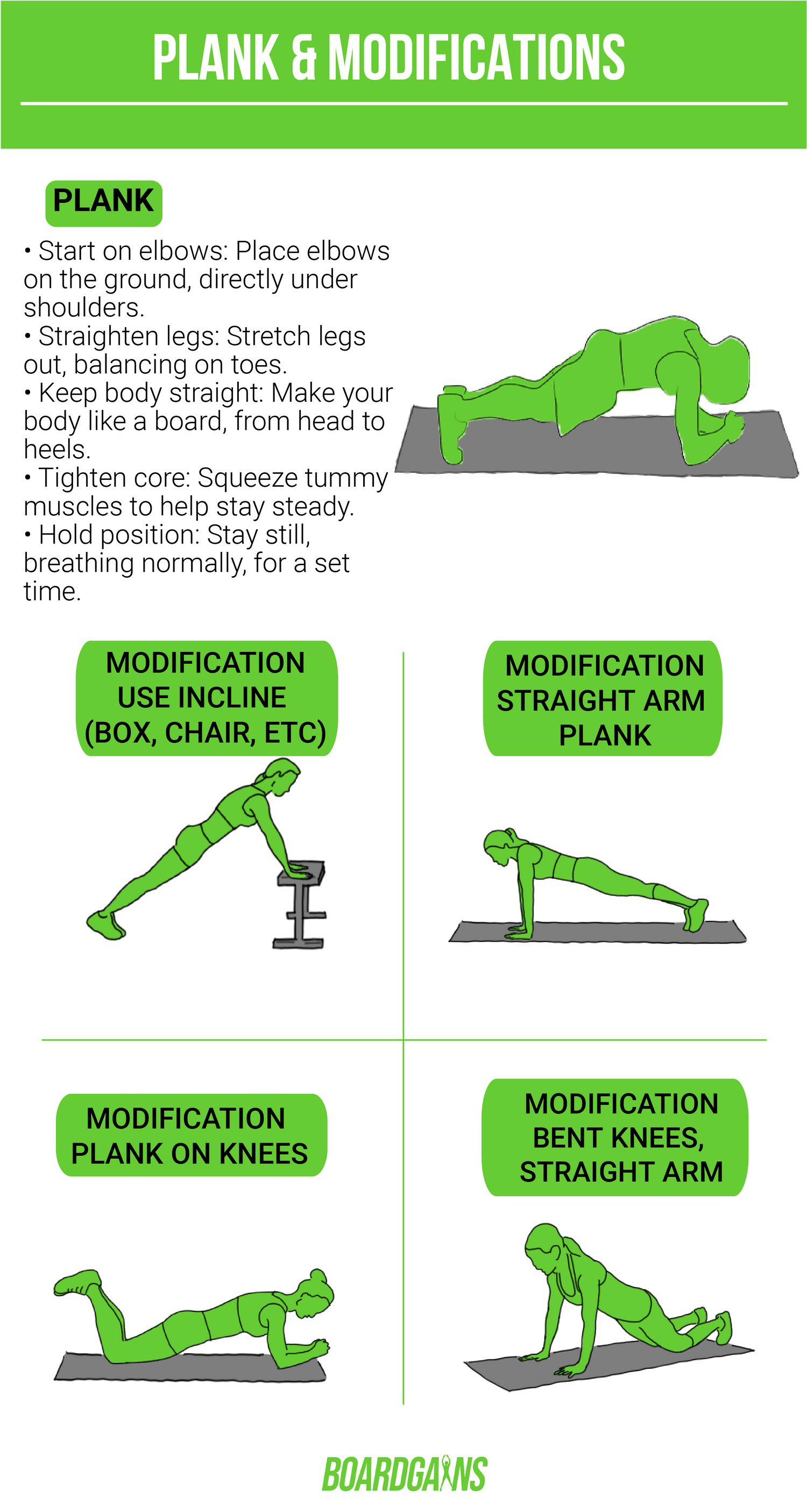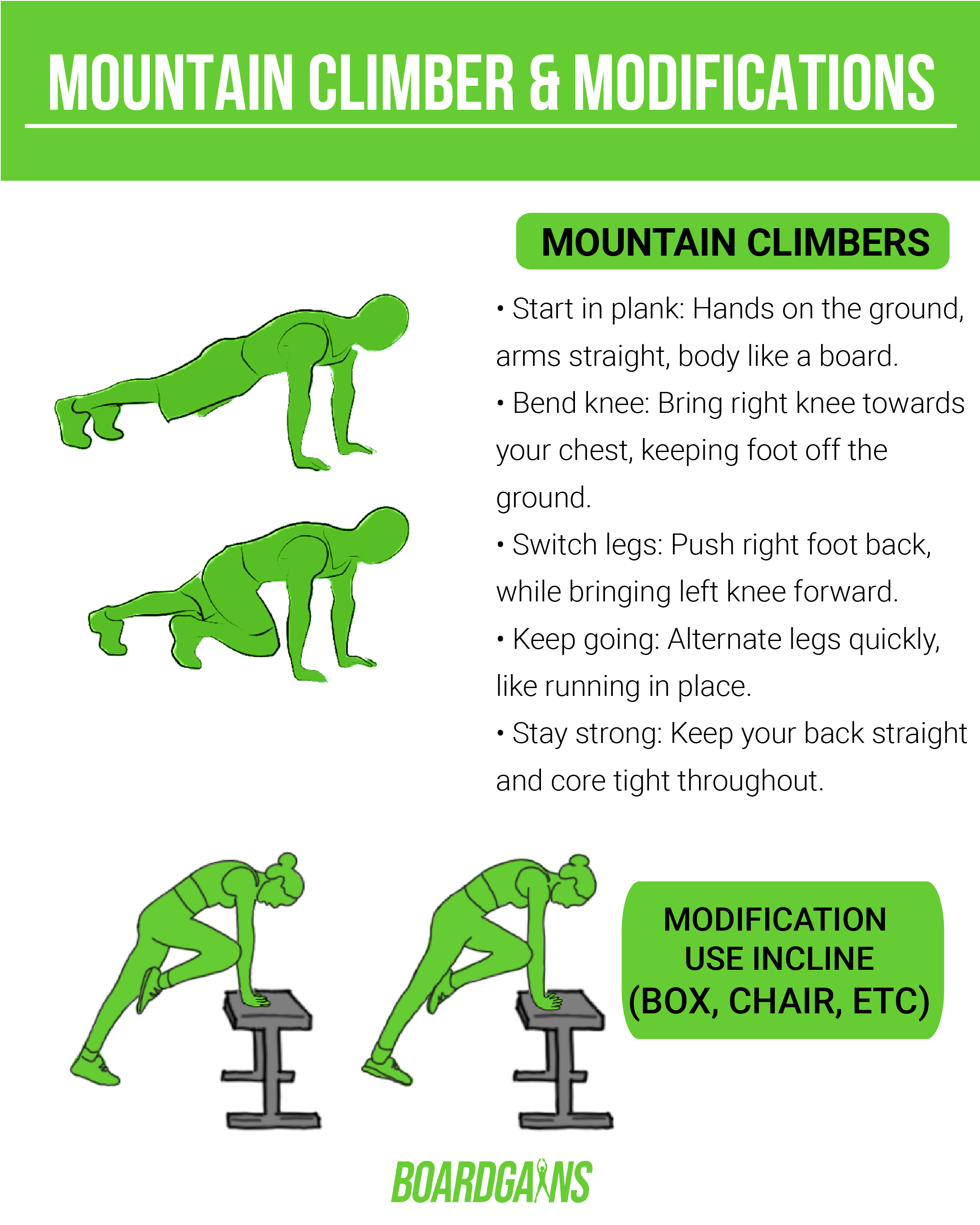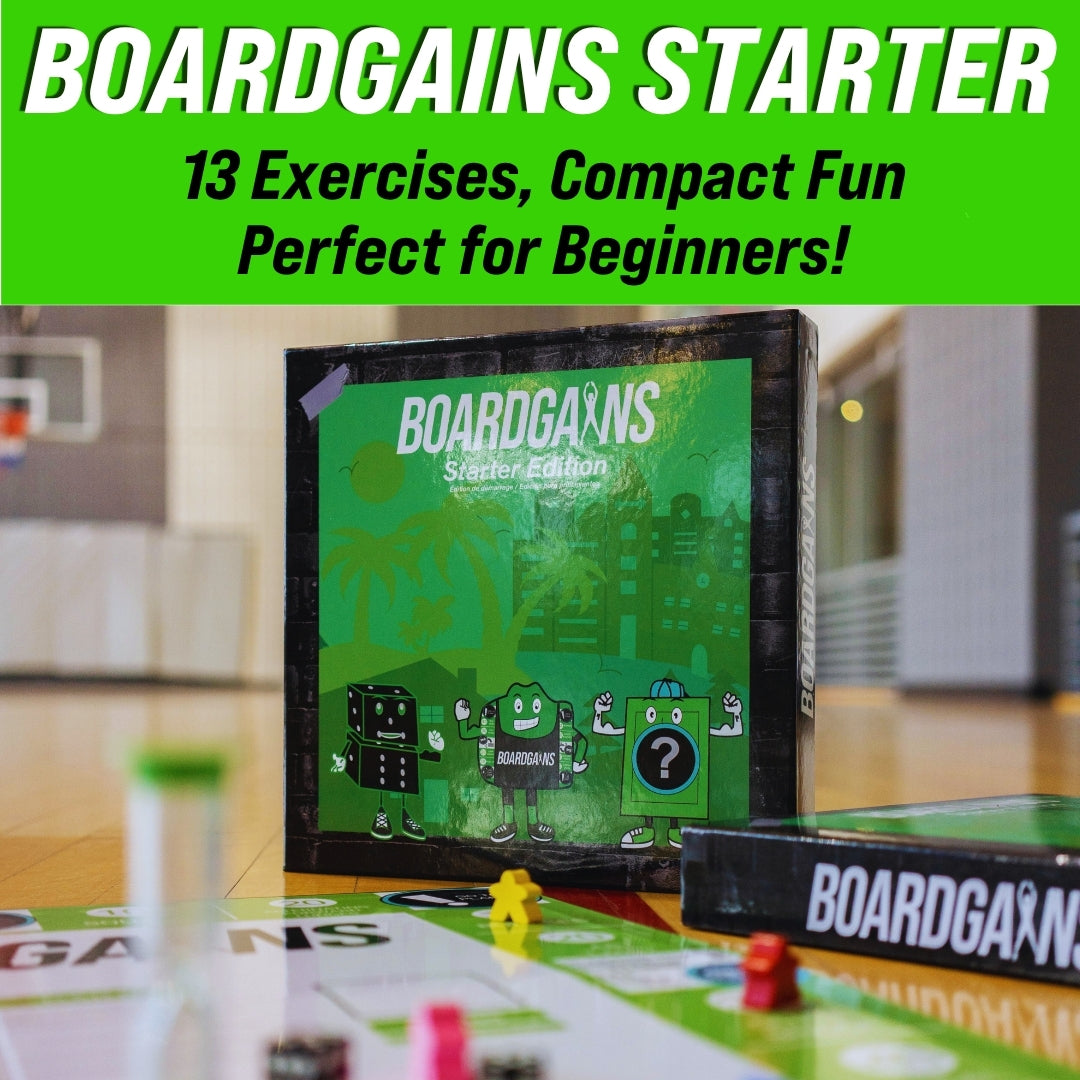The plank is a highly effective exercise that targets multiple muscle groups in the body, including the core, upper body, and lower body. It is a simple yet challenging exercise that can be performed anywhere with no equipment required. At Boardgains, we love incorporating this fun and challenging exercise into our fitness board game. In this article, we'll cover the benefits, proper technique, dos and don'ts, common mistakes, tips, and more about the plank exercise.
How To Plank (English):
- Start by getting into a push-up position with your forearms on the ground and your elbows directly under your shoulders.
- Keep your body in a straight line from head to heels, engaging your core and glutes.
- Hold the position for the desired amount of time, maintaining good form and breathing regularly.
Modification: Straight arm plank, knees on floor, knees on floor with straight arm plank (Watch video for modification)
2. What is the plank exercise?
The plank exercise is a static bodyweight exercise that targets the core, glutes, legs, and upper body. It involves holding a position similar to the top of a push-up, with your body in a straight line from head to heels.
3. How to perform the basic plank exercise correctly
Here are the steps to perform the basic plank exercise correctly:
- Get into a push-up position, with your hands shoulder-width apart and your feet hip-width apart.
- Make sure your wrists are directly under your shoulders and your back is straight.
- Engage your core muscles and squeeze your glutes.
- Hold the position for 30-60 seconds or as long as you can maintain proper form.
- Lower your body to the floor and rest for a few seconds before repeating.
4. Common mistakes to avoid while doing plank
Here are some common mistakes to avoid while doing the plank exercise:
- Arching your back: This puts undue pressure on your lower back and can cause injury. Keep your back straight and engage your core muscles.
- Dropping your hips: This takes the pressure off your core and makes the exercise less effective. Keep your hips level with your shoulders and ankles.
- Holding your breath: Breathe deeply and evenly throughout the exercise to avoid muscle fatigue and dizziness.
- Placing your hands too close together: This can cause shoulder pain and instability. Keep your hands shoulder-width apart.
5. Advanced plank variations for a more challenging workout
Once you've mastered the basic plank exercise, you can try these advanced plank variations for a more challenging workout:
- Side plank: Lie on your side and prop yourself up on one elbow. Lift your hips off the ground and hold the position for 30-60 seconds before switching sides.
- Elevated plank: Place your feet on a raised surface, such as a bench or step, and hold the plank position for 30-60 seconds.
- Plank with leg lifts: Lift one leg off the ground while holding the plank position, then switch legs and repeat.
- Plank with arm lifts: Lift one arm off the ground while holding the plank position, then switch arms and repeat.
- Plank with knee tucks: Bring one knee to your chest while holding the plank position
6. The benefits of plank exercise
There are numerous benefits of incorporating plank exercise into your fitness routine, such as:
-
Improving core strength: Plank targets the core muscles, including the transverse abdominis, rectus abdominis, and obliques, helping to strengthen and tone them.
-
Reducing the risk of back pain: By strengthening the core muscles, plank can help improve posture and reduce the risk of back pain.
-
Enhancing overall body stability: Plank requires holding a static position, which can help improve overall body stability and balance.
-
Boosting metabolism: Plank engages multiple muscle groups, which can help boost metabolism and burn calories.
-
Improving flexibility: Plank can help improve flexibility in the posterior muscle chain, including the hamstrings, glutes, and calves.
7. Precautions to take while doing plank
While plank is a safe exercise for most people, there are some precautions you should take to avoid injury:
- If you have a history of back pain or injury, consult your doctor or physical therapist before attempting plank exercise.
- Avoid holding your breath while performing the exercise, as this can cause dizziness and fatigue.
- Start with the basic plank exercise and gradually progress to more advanced variations as your strength improves.
- If you experience pain or discomfort while performing plank, stop immediately and rest.
8. How often should you do plank exercise?
To see the best results from plank exercise, it's recommended to perform it 2-3 times a week, with at least 24-48 hours of rest between each session. It's important to gradually increase the duration and intensity of the exercise to avoid injury.
9. Incorporating plank into your fitness routine
Plank can be incorporated into your fitness routine in several ways, such as:
- Adding it to your warm-up or cool-down routine.
- Performing it as a standalone exercise for a specific amount of time or number of reps.
- Combining it with other bodyweight exercises for a full-body workout.
10. Conclusion
Plank exercise is a simple yet effective way to improve core strength, stability, and endurance. By following the proper form and technique, avoiding common mistakes, and gradually progressing to more advanced variations, you can see numerous benefits such as reducing back pain, enhancing body stability, and improving flexibility. Incorporate plank into your fitness routine 2-3 times a week for best results.
11. FAQs
Is plank exercise good for weight loss?
Plank exercise can help boost metabolism and burn calories, making it a great addition to a weight loss program.
Can I do plank exercise every day?
While it's possible to do plank exercise every day, it's recommended to give your body at least 24-48 hours of rest between each session to avoid injury.
What muscles does the plank exercise work?
Plank primarily targets the core muscles, including the transverse abdominis, rectus abdominis, and obliques, as well as the glutes, legs, and upper body.
How long should I hold the plank position?
Beginners should aim to hold the plank position for 30-60 seconds, while more advanced exercisers can aim for 1-2 minutes or longer.
Can I do plank exercise during pregnancy?
While plank exercise is generally safe during pregnancy, it's important to consult with your doctor or physical therapist before attempting it, as modifications may be necessary.










Leave a comment
This site is protected by hCaptcha and the hCaptcha Privacy Policy and Terms of Service apply.